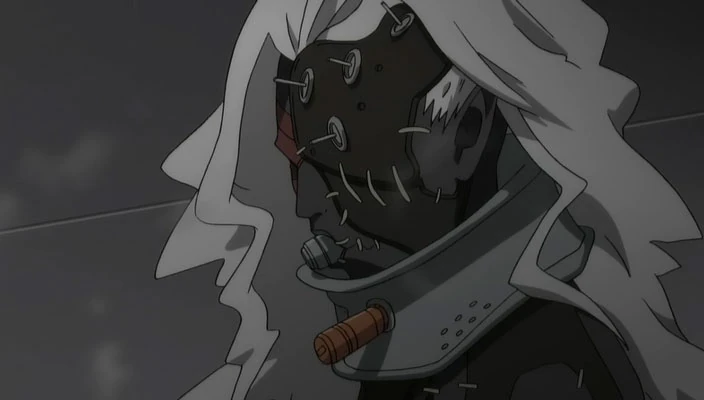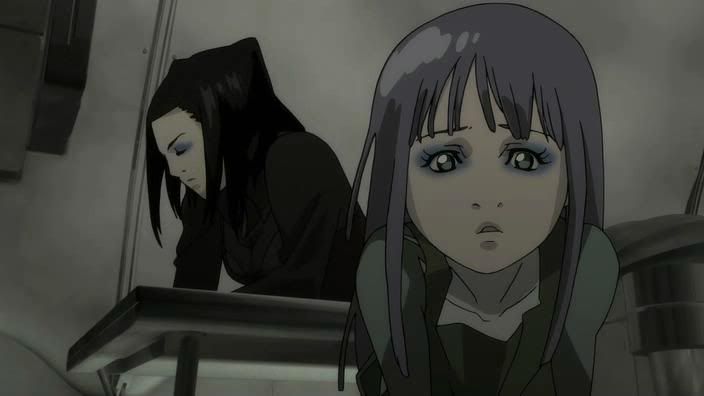 |
| From http://img11.deviantart.net/b727/i/ 2006/290/0/d/ergo_proxy2_by_sage666.jpg |
Director: Shukō Murase
Screenplay: Dai Sato; Junichi
Matsumoto; Naruki Nagakawa; Seiko Takagi; Yuuko Kawabe; Yuusuke Asayama
Based on an original premise
Voice Cast: Rie Saitou (as Re-l
Mayar); Akiko Yajima (as Pino); Koji Yusa (as Vincent Law); Hikaru Hanada (as
Raul Creed); Kiyomitsu Mizuuchi (as Iggy); Sachiko Kojima (as Monad); Sanae
Kobayashi (as Daedalus Yumeno)
Ergo Proxy is a perfect case study of how an anime television
series, especially when it has over twenty episodes rather than twelve or
thirteen to work with, can be a rollercoaster in terms of how a show can
drastically change from its first episode to the finale. Here, what begins as
one type of story changes so much in terms of what happens to the characters
that it feels like a lot of time and events have passed. Whether Ergo Proxy does succeed in doing this
well is to be described throughout the review, but when it succeeds in other
anime television, even if there're hiccups along the way, it's so much more
rewarding in fact than some tight, thirteen episode anime or animated films in
letting the world feel fleshed out and unpredictability becoming involved.
 |
| From https://canime.files.wordpress.com/2009/06/ergo6.jpg |
Ergo Proxy starts as a dystopian sci-fi story set in a post-apocalypse
world. In the last surviving city of Earth, Romdeau, the populous are
controlled by the state, ran by a Regent assisted by intelligent artificial
intelligences housed in animated Greek statues and various departments of
control. Mankind is to control their emotions, following their robot assistants
called "Entourages" carefully and consumer products. The granddaughter
of the current Regent is Re-l, a member of Citizens Intelligence Bureau who is
currently investigating the effects of the Cognito virus, causing self
awareness and consciousness to grow in the entourages. While investigating this
however, Re-l discovers the existence of a strange and monstrous figure the
authorities are trying to suppress knowledge of. Discovering the monstrous
figure is a "Proxy", and that there are more than one of them, she
finds herself being watched even through her robotic partner Iggy and compromised
by everyone including the security group led by Raul Creed.
 |
| From http://ecx.images-amazon.com/images/I/4106sNGWrCL.jpg |
Very much catering to a Western
audience, the first quarter of the series is a post-Ghost In The Shell franchise creation, very much trying to
replicate the mix of seriousness and action of Mamoru Oshii's 1995 adaptation and the other adaptations from other
directors after that. Significantly though, while Oshii's films, including the sequel, had actual philosophical
discussions, Ergo Proxy merely tries
to have philosophical sounding dialogue discussing fate and existence, placing
it very much in the ballpark of anime earnestly taking on serious pathos to
their material, mixing this with moments of action. It's black, grey and brown
hued colour is immediately striking at first - Re-l is as Goth as you can get
with her Panda eye purple eyeliner, black night clubbing clothes and boots, and
a long trench coat - but it eventually becomes repetitive immediately after the
first couple of episodes, causing one to desire more colour and the story to
escape the oppressively drab Romdeau. Tonally it's better keeping you engaged, appropriately
bleak without becoming morose, more so that in catering to its Western
influences the production went as far as having Radiohead's Paranoid Android
used as the end credits song, thankfully able to be kept for the Western
releases out of permission from the band themselves and apt for the tone of the
work.
 |
| From http://vignette4.wikia.nocookie.net/ergoproxy/images/8/80/ Monad-proxy.jpg/revision/latest?cb=20100711185939 |
Things become more interesting as
the world opens up beyond Romdeau, when its revealed there's more to the world
in spite of people dying in the wasteland if they are not treated to adjust to
the contaminated air. Re-l with her robot partner Iggy encounter Vincent Law,
an "immigrant" whose connection to the proxies force him on the run
from Romdeau's forces, and Pino, a small robotic girl originally built as a
surrogate child whose is infected by the Cognito virus, becoming more human
than some actual humans as she acts like an actual girl who loves life and is
naturally curious about everything around her. Vincent Law in particular is as
stereotypical as you can get for the show, the shy guy whose secret dark side
is another stereotype in itself when its finally revealed, but as the shows
escapes the trappings of replicating a cyberpunk mystery the characters in
spite of their stereotypical behaviours get more interesting as the show strays
off its narrative path. Pino in particular is the most rewarding character in
terms of entertainment; thankfully she is never viewed in a sexual light, and
while she is the stereotypical cute child who wears a pink bunny costume a
great deal, she is a lovable character who is far from annoying. Because of Akiko Yajima 's voice acting and how the character is depicted, she is loveable
in an admirable way with her mimicking of other's behaviour and friendliness.
That she's a robot with a soul adds to her character a great deal without
blatantly discussing it at length as does when she has to learn of concepts
such as death without the show becoming morbid about such moments.
 |
| From https://lh5.googleusercontent.com/-SZxS5AnrZUU/TnlbH7VkKwI/AAAAAAAAQyo/w1 7JrqJ_sBo/s800/Ergo%252520Proxy%252520-2.jpg |
When the show reaches its halfway
point it almost entirely severs itself from a direct narrative and the city of Romdeauas
the protagonists explore the other cities in the wasteland. Not only does the
aesthetic style improve as more of the world is shown - cities where only the
robots remain to populate them doing their chores on deserted streets, an
amusement park dome, dark caves containing mutants - but this is a case where
it's the filler episodes, episodic tales, that prove to be stronger than the
actual narrative in construction. I was not a fan of filler episodes once but
that's changed as I realise how useful and fun they can be. It helps that this
show's episodes still drip feed important plot points, as the show intercuts
back to Romdeau to follow both Creed and Daedalus
Yumeno, a young male doctor whose emotional connection to Re-l becomes
problematically obsessive when she is gone, allowing a narrative to still be
built. But the episodes where the protagonists step out of the main narrative, barring
some small plot details, help flesh them out immensely. Some of the episodes
are deliberately abstract in tone, facing possible doppelgangers or Vincent entering
a subconscious encounter with his darker self involving a book seller, and
others are deliberately jarring. What could become a monster of the week show
when other proxies are revealed becomes more of the production team likely
stepping out and experimenting with their material, thus letting down their
hair and becoming incredibly creative.
 |
| From http://media9.fast-torrent.ru/media/files/s3/dm/ps/ergo-proksi.png |
One episode for example, even
playing with the opening credits for a fourth wall joke, is literally a game
show, out of the blue and the best episode of the whole series as it crams
major background story into its form, questions to baffled protagonists, and is
completely jarring, the bright colours of a studio set drastic alongside its
cheerful tone in spite of the fact the loser of the show's game will be killed.
Another, which is another candidate for the best episode, involves the
aforementioned amusement park dome, turning the serious show into a tribute to
classic western animation like the Fleischer
brothers and explicitly referencing Walt Disney. When the show does swerve into
episodes like this, the virtues long form anime series can have with longer
lengths is shown, adding to each characters' personality in spite of their stereotypical
ticks and keeping material fresh; for another great example, one where the
heroes are stranded in wasteland, you get to see Re-l develop into more than a
moody female protagonist when she starts to go stir crazy over simple things as
Vincent leaving the toilet seat up, bringing normalcy in a humorous way into a
sci-fi story. Whilst a thirteen or so episode series can prevent a story from
becoming meandering and improvising episodic plots badly, shows with longer
lengths can allow to use the unpredictable to their advantage, the
rollercoaster as mentioned in the beginning, where a serious show visibly and
tonally in debt to Ghost in the Shell
ends up with a character having two anthropomorphic comedy sidekicks for a late
episode. This also helps as, once some colour and further personality beyond Romdeau's
conformist greys and blacks is added, Ergo
Proxy has a high artistic quality to admire. Great animation is added to
the bleakness of the world, destroyed by an unknown plight and adding religious
tones to the plots' secrets, fleshing it out further. It's clichéd as hell as a
story, as massive and monstrous humanoids called proxies tear chunks out of
each other if they cross paths, scored characters named after philosophers
talking about fate to the cast, but once the filler episodes allow the
animation to stretch its legs and do more, the seriousness starts to be
sincerer.
 |
| From https://s-media-cache-ak0.pinimg.com/736x/a3/ d9/95/a3d995938c30554d307f225a7d64b9cc.jpg |
It's unfortunate however, despite
how rewarding the series is, that the last three episodes feel so abrupt,
returning back to Romdeau with a sudden, undisclosed jump in time where chaos
has reached the streets. One flaw with the Romdeau setting is that, despite
there being background characters, the show from the beginning felt empty in
terms of scope, with no one baring silhouettes in the background to add meat to
the dystopian tones. When it returns to Romdeau in the midst of chaos, without
showing the cause of it barring hinted dialogue in an earlier episode, and with
only a few riots killing entourages to represent it, the shift is lacking. Trying
to quickly tie together its narrative, it becomes a series of muddled
monologues and unexpected religious imagery that, while eye catching, does jar
with what came before unlike the game shows and Disney references which were playful and by themselves. The show's attempts
at serious philosophy eventually collapse into one of the worst stereotypes of
anime when characters deliver convoluted monologues in the middle of a final
fight instead of trying to actually fight , vague and against the more rewarding
material of before.
 |
| From http://i2.photobucket.com/albums/y7/n00dle_king/lolilil.jpg |
And in lieu of how like a rollercoaster
the show already is, its disarming that a science fiction story which does hint
at spirituality and fantasy, but grinds it into some natural reality, suddenly
ends with such a scene as a feather winged woman, a doppelganger of another,
carrying another person by the hand up into the clouds in a mix of Icarus and
an angel taking someone to heaven. While it could've worked perfectly if the
religious overtones had been more prevalent in the earlier chapters, the
ultimate flaw with Ergo Proxy is
that its structure is a mess because of the ending, the main narrative far less
interesting than the tangents it goes into with the attempts to make the narrative
engaging by its end abrupt. What actually hit a great groove of quality from
episode fifteen onwards, where even predictable episode plots sparkled with
importance for characters and plot, is disappointed when the structure is lets
the side down. Ergo Proxy still can
raise its head high for some utterly memorable middle episodes, proof filler
can be healthy for the show, but it fails when it needed to climax perfectly.
 |
| From http://burrowowl.net/wordpress/wp-content/ uploads/2006/09/ergo_proxy_19_will.jpg |
No comments:
Post a Comment